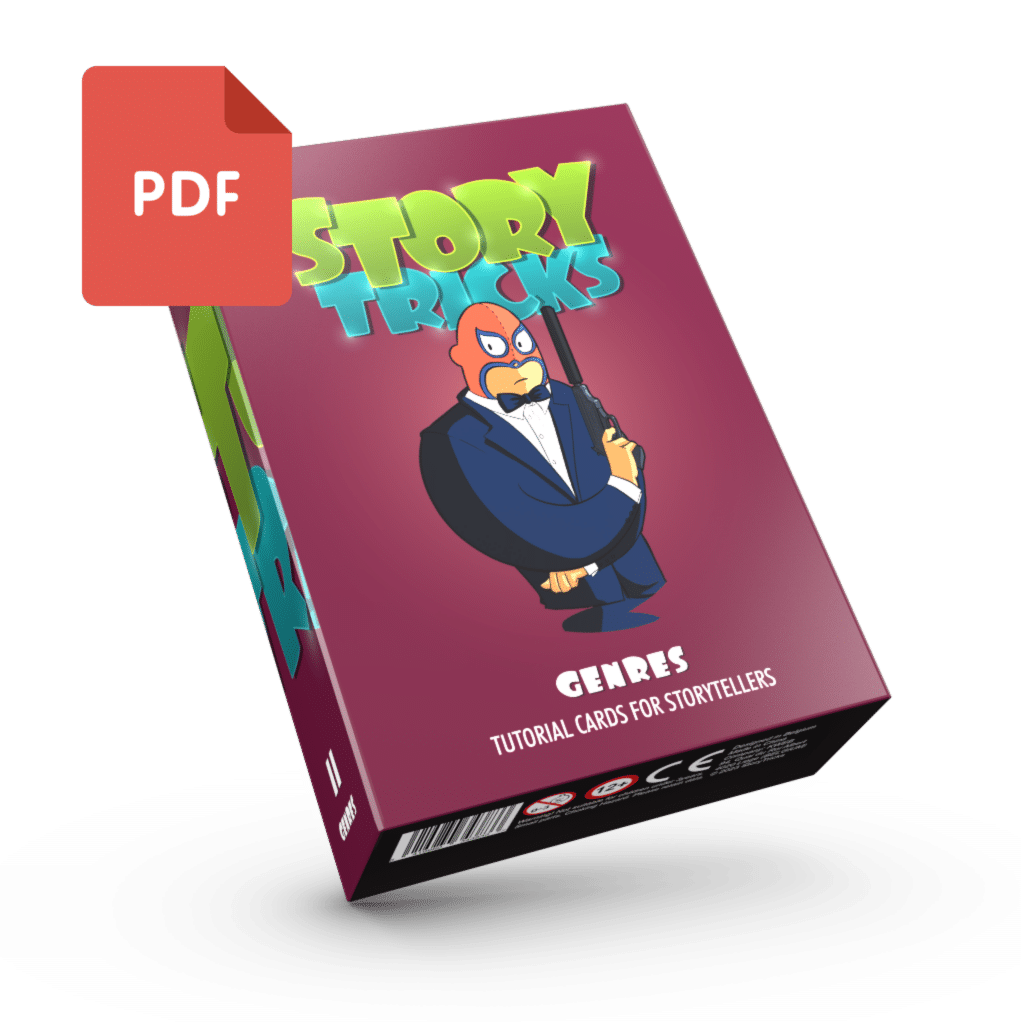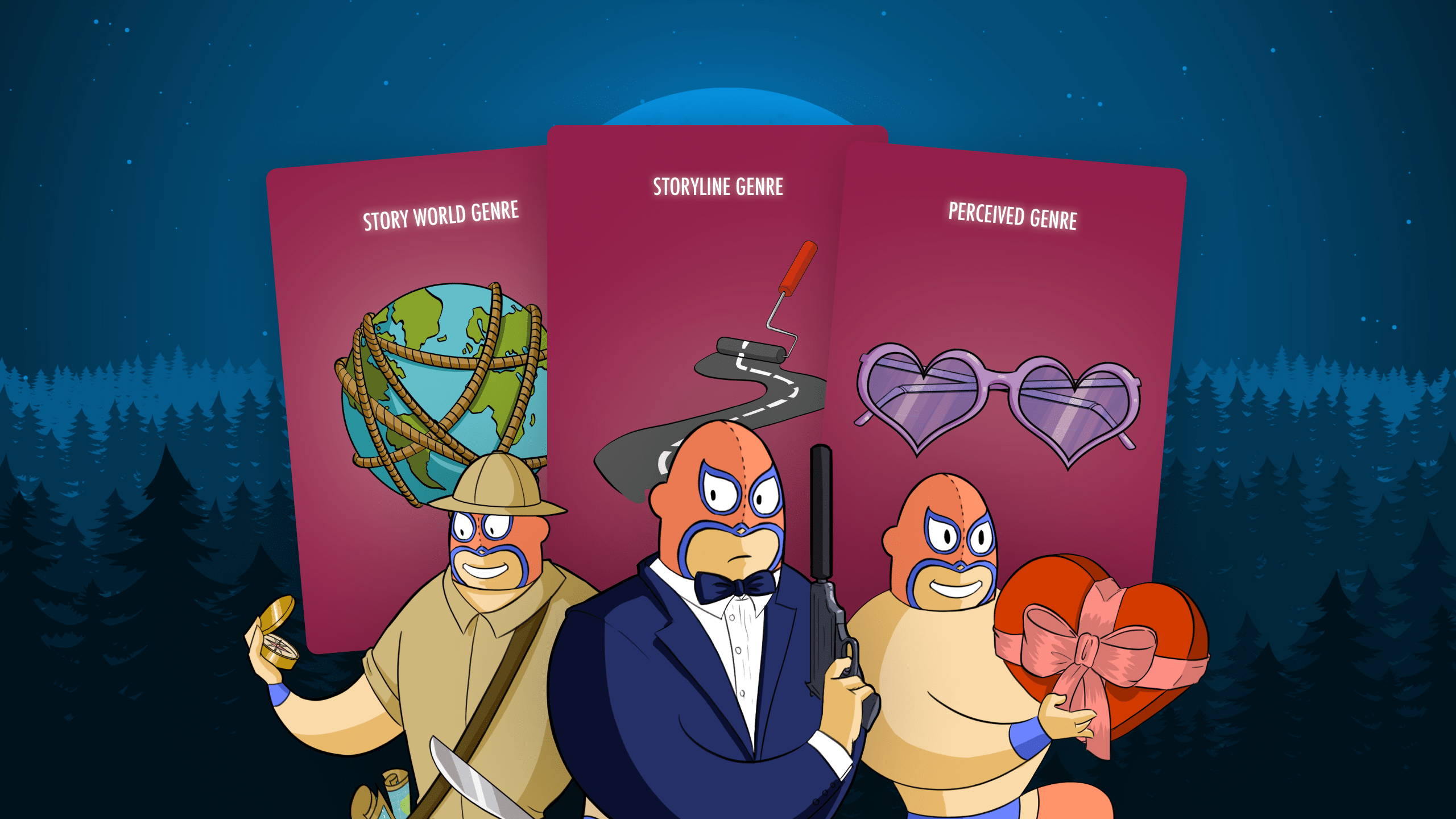Mastering Genre Blending is a powerful way to create original and compelling stories. As writers, we often find ourselves captivated by stories that transcend the boundaries of a single genre. These tales resonate deeply because they weave together elements from multiple genres, creating rich, multifaceted narratives that can captivate diverse audiences.
This technique, known as genre blending, can be both exhilarating and challenging. However, with the right approach and tools, such as the StoryTricks cards, you can master the art of genre blending to craft compelling stories that stand out.
Related Deck

Genres Deck
Limited genres, endless stories!
Mix 10 main genres and 36 subgenres with our unique genre-blending recipe for originality.
Table of Contents
Understanding Genre Blending
Genre blending involves combining characteristics from two or more genres to create a unique and engaging narrative. For instance, a story might blend the suspense and horror of a thriller with the emotional depth and complexity of a drama. This fusion allows writers to explore new creative avenues, engage a wider audience, and infuse originality into their storytelling.
The Three Pillars of Genre Blending
To effectively blend genres, it’s essential to understand and leverage three key concepts: Story World Genre, Storyline Genre, and Perceived Genre. Each of these elements plays a crucial role in shaping the narrative and influencing how the story is received by the audience.
Story World Genre
The Story World Genre sets the stage for your narrative, defining the broader environment in which your story takes place. This includes the time period, location, societal norms, and overall atmosphere. The Story World Genre provides the backdrop against which your characters and plot unfold.
For example, a Story World Genre could be a dystopian future, a magical fantasy realm, or a contemporary urban setting. The key is to choose a world that not only fascinates your audience but also supports the blending of different genres.
Example: Imagine a dystopian future where society is divided into strictly controlled sectors, each with its own distinct culture and challenges. This world provides a fertile ground for blending genres like sci-fi, thriller, and romance.
Storyline Genre
The Storyline Genre focuses on the main plot and narrative structure of your story. It involves the core events, conflicts, and resolutions that drive the story forward. While the Story World Genre sets the stage, the Storyline Genre defines the action and drama within that world.
Blending genres at the storyline level involves integrating different plot elements, such as combining the suspense of a mystery with the high-stakes adventure of a heist. The goal is to create a plot that keeps the audience engaged and invested in the outcome.
Example: In our dystopian world, the main storyline could revolve around a group of rebels planning a daring heist to overthrow the oppressive regime. This storyline blends elements of action, suspense, and political intrigue.
Perceived Genre
The Perceived Genre is how the audience interprets and categorizes your story. It’s the emotional and thematic essence that resonates with readers or viewers. While the Story World and Storyline Genres are more structural, the Perceived Genre is about the overall impact and takeaway.
To master genre blending, consider how you want your audience to feel and what themes you want to highlight. This could involve blending the emotional resonance of a drama with the excitement of an action-packed adventure.
Example: The perceived genre of our dystopian heist story could be a mix of thrilling adventure and poignant drama, as the characters’ personal struggles and sacrifices add depth to the high-stakes action.
Crafting a Genre Pitch
A genre pitch is a concise summary that highlights the blended genres of your story, showcasing its unique appeal. This pitch should encapsulate the essence of your narrative, combining elements from the Story World Genre, Storyline Genre, and Perceived Genre.
Steps to Create a Genre Pitch:
- Identify Your Core Genres: Determine the primary genres you want to blend. Consider the strengths and characteristics of each genre and how they can complement each other.
- Define the Story World: Set the stage with a compelling Story World Genre. Describe the setting and atmosphere in a way that supports your chosen genres.
- Outline the Main Plot: Craft a brief summary of the main storyline, emphasizing the blended elements. Highlight the key conflicts and events that drive the narrative.
- Convey the Perceived Genre: Describe the emotional and thematic impact of your story. Explain how the blended genres create a unique and engaging experience for the audience.
Example Genre Pitch:
In a dystopian future where society is divided into rigid sectors, a group of rebels plans a daring heist to overthrow the oppressive regime. As they navigate the dangerous world of high-tech security and political intrigue, they must also confront their personal demons and sacrifices. This thrilling adventure blends the suspense of a sci-fi thriller with the emotional depth of a character-driven drama, offering a compelling narrative that explores themes of freedom, loyalty, and redemption.
Utilizing StoryTricks Cards for Genre Blending
The StoryTricks cards offer valuable tools to help you blend genres effectively. Here’s how each deck can support your genre-blending efforts:
Framing Deck
The Framing Deck helps you establish the overarching structure of your story, including its theme, setting, and core concept. Use these cards to build a solid foundation for your Story World Genre, ensuring that your setting is both engaging and supportive of the genres you wish to blend.
Example: Utilize the Framing Deck to flesh out the dystopian society, detailing its rules, divisions, and atmosphere. This foundation will help you create a believable and immersive world for your story.
Genres Deck
The Genres Deck provides insights into different genres and how to incorporate their specific elements into your narrative. This deck is crucial for understanding genre conventions and how to blend them seamlessly.
Example: Refer to the Genres Deck to explore the conventions of sci-fi, thriller, and drama. Identify key elements from each genre, such as high-tech gadgets from sci-fi, suspenseful plot twists from thrillers, and emotional character arcs from dramas.
Characters Deck
The Characters Deck focuses on developing multidimensional characters. Use these cards to create characters that fit well within your blended genres, ensuring they are complex and relatable.
Example: Develop characters who are not only skilled rebels but also have deep personal motivations and emotional struggles. This adds depth to the action-driven plot and enhances the overall impact of the story.
Structure Deck
The Structure Deck guides you in outlining the sequence of events and pacing of your story. This is essential for maintaining a cohesive narrative when blending genres, as it ensures a balanced mix of action, suspense, and emotional beats.
Example: Use the Structure Deck to plan the heist’s progression, integrating moments of high tension with character-driven scenes that explore personal sacrifices and relationships.
Empathy Deck
The Empathy Deck helps you evoke emotions and build a strong connection between your story and the audience. This is vital for the Perceived Genre, as it shapes how the audience experiences and remembers your story.
Example: Employ the Empathy Deck to craft scenes that highlight the emotional stakes of the heist, such as moments of camaraderie among the rebels or the personal costs of their mission. This enhances the dramatic impact and emotional resonance of the narrative.
Tips for Successful Genre Blending
- Respect Genre Conventions: While blending genres, it’s important to respect the conventions of each genre. Understand what makes each genre appealing and ensure these elements are present in your story.
- Maintain Balance: Strive for a balanced integration of genres. Avoid overwhelming the audience with too many conflicting elements. Focus on creating a harmonious blend that enhances the story rather than complicating it.
- Develop Strong Characters: Well-developed characters can bridge the gap between genres. Ensure your characters are relatable and their arcs resonate with the blended genres.
- Focus on Themes: Themes can serve as a unifying thread when blending genres. Identify common themes that run through the genres you are blending and highlight them in your story.
- Test and Refine: Genre blending is an iterative process. Test your story with readers and refine based on feedback. Pay attention to how well the blended genres work together and make adjustments as needed.
Conclusion
Genre blending offers a powerful way to create unique and captivating stories. By understanding and leveraging the concepts of Story World Genre, Storyline Genre, and Perceived Genre, you can craft narratives that resonate with a wide audience. The StoryTricks cards provide invaluable guidance and tools to help you navigate the complexities of genre blending, ensuring your stories are engaging, well-structured, and impactful.
Embrace the challenge of genre blending and explore the creative possibilities it offers. With careful planning and the right resources, you can master this technique and elevate your storytelling to new heights.
Related Deck

Genres Deck
Limited genres, endless stories!
Mix 10 main genres and 36 subgenres with our unique genre-blending recipe for originality.
Useful Links
Reedsy – How to Choose Your Book Genre
A detailed guide on understanding and choosing the right genre for your book.
Writer’s Digest – Tips on Writing Across Genres
Insights into the benefits and challenges of writing in multiple genres.
https://www.writersdigest.com/write-better-fiction/writing-across-genres
The Creative Penn – How to Write a Series: 5 Tips
Advice on writing a series, especially when blending genres.
https://www.thecreativepenn.com/2019/07/10/how-to-write-a-series/
MasterClass – Story Structure: 7 Narrative Structures
An overview of different narrative structures that can be used in genre-blending.
https://www.masterclass.com/articles/how-to-structure-a-story
NY Book Editors – How to Craft Complex Characters
Techniques for developing multi-dimensional characters in any genre.
https://nybookeditors.com/2019/04/crafting-complex-characters/
K.M. Weiland – Genre and the Importance of the Tropes
An exploration of genre tropes and how to use them effectively.
https://www.helpingwritersbecomeauthors.com/genre-and-tropes/
Purdue Online Writing Lab (OWL) – Writing a Book Report
Guidelines on writing book reviews, useful for analyzing genre-blending works.
https://owl.purdue.edu/owl/subject_specific_writing/writing_in_literature/book_review.html
The Write Practice – How to Write a Genre Story
Step-by-step instructions on writing stories within a specific genre.
Well-Storied – Genre Writing: World-Building Tips
World-building strategies that are crucial in genre-blending narratives.
ProWritingAid – Genre and Style Checker
A tool for analyzing the genre and style of your writing to ensure consistency.
https://prowritingaid.com/en/Resources/Checks/Genre-and-Style
